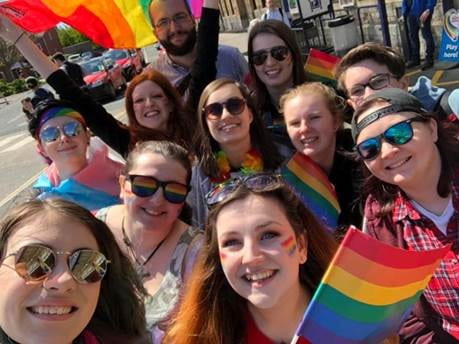[LGBT] [Sexual Orientation] [Gender Diversity]
DEFINITION
It is important to realise that the term LGBT (which stands for Lesbian, Gay, Bi-sexual, Transgender) is an umbrella term pertaining to both sexual AND gender diversity. These two areas need to be separated out in order to provide any useful information and tips for inclusivity. The two sub-sections ‘Sexual Orientation’ and ‘Gender Diversity’ are therefore preferred recommended reading, although a few generic tips are provided here for ease.
When the umbrella term LGBT is used it is generally accepted to refer to the population (or topics related to) who identify with:-
- sexual orientations including lesbian, gay, bi-sexual and asexual (the LGB bit)
- genders which are not the same as, or do not sit comfortably with, the sex they were assigned at birth (the T bit). Trans people may describe themselves using terms including (but not limited to) transgender, transsexual, gender-queer (GQ), gender-fluid, non-binary, gender-variant, crossdresser, genderless, agender, nongender, third gender, bi-gender, trans man, trans woman, trans masculine, trans feminine and neutrois.

TOP TIPS
- Read the sub sections here on sexual orientation and gender diversity, understand the key terms (resource link here).
- Watch this video on gender diversity:- Video about a relationship where one comes out as gender non-binary
- If a student chooses to come out to you – please respect that, do not tell them to find student support – they have chosen you for a reason. Find a confidential space and listen to them. You may not feel knowledgeable enough to advise, but listening in itself is a powerful statement. If it becomes clear that they need and want further help, you can then help them to engage with that.
- If a trans student chooses to come out to you, it will be important to ask them the pronouns they use and the terms they use for their gender and identity. Don’t make any assumptions. Make sure you understand the terms and respect their confidentiality/wishes in how they wish to be identified when in teaching sessions.
- Discuss and raise issues of both sexual orientation and gender diversity where appropriate to provide an inclusive curriculum/campus. Celebrate diversity within all environments to provide a message that our community is an inclusive one.
- Be clear about what teaching sessions will cover in advance, particularly where they are likely to cover any sensitive topics of sexual orientation and gender diversity, to give students advance notice and an opportunity to raise any concerns they may have.
- Gender neutralise your language where you can – is gender relevant to what you are discussing?
- Consider adding your pronouns to your University email address (eg she/her/hers) – this gives a strong message that you are aware of Trans issues and respect gender diversity.
- If someone points out you have mis-gendered them, say sorry quickly, correct yourself and move on (don’t make a fuss!)
- Ensure any systems you use and surveys you send recognise more than two genders and allow for changes to gender markers, names and IDs.
- Ensure any processes you use (such as those inviting students/staff to interviews or PDTs) provide opportunity for individuals to disclose how they wish to be addressed and therefore avoid mis-gendering. (Asking for gender rather than sex is useful).
- Be an active bystander – if you witness hostile, intimidating or discriminatory behaviours, take action and report incidents.
- When considering facilities and physical changes being made to the environment, consider inclusive usage.
FURTHER INFORMATION AND ADVICE
There is evidence to suggest that retention and outcomes for LGBT students can be adversely affected when they face educational inequalities (see for instance “Supporting Transgender and Non-Binary Students and Staff in Further and Higher Education” by Dr M Lawrence and Dr Stephanie Mckendry, 2019).
It is not only students who can be negatively affected by inequalities, the same research above also shows that trans and gender diverse employees face a multitude of challenges whilst elsewhere the Department for Business, Innovation and Skills put forward a business case for equality and diversity in 2013 where they were able to justify their statement that more inclusive workplaces can be more productive.
RESOURCES
Further resources which you may find helpful can be found at:-
Stonewall was founded in 1989 following the struggle against Section 28 of the Local Government Act and the Stonewall riots. It began as an LGB organisation but became trans inclusive in 2015. A vast array of resources related to education and employment are available from:- https://www.stonewall.org.uk/ and you may find this piece on coming out particularly useful:- https://www.stonewall.org.uk/help-advice/coming-out/coming-out-adult-1.
Gendered Intelligence are an organisation that exist to educate in all sectors on gender diversity. Their website is here:- http://genderedintelligence.co.uk/ and you may find this piece useful specifically on non-binary identities:- https://cpb-us-e1.wpmucdn.com/sites.marjon.ac.uk/dist/4/1635/files/2018/11/Understanding-Non-binary-Gendered-Intelligence-November-2016.pdf
GIRES, Gender Identity Research & Education Society have excellent resources for teaching staff preparing to input on gender diversity in teaching sessions :- https://www.gires.org.uk/
Other resources and useful organisations can be found under the Resources section of this toolkit.
[LGBT] [Sexual Orientation] [Gender Diversity]